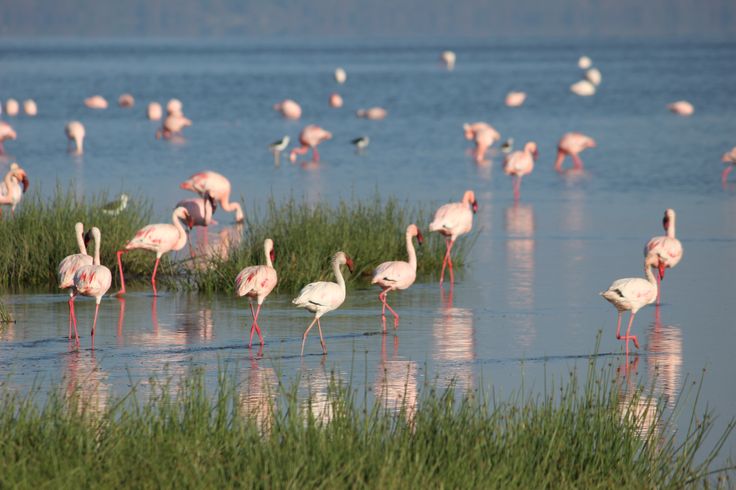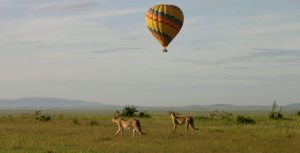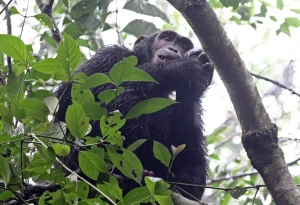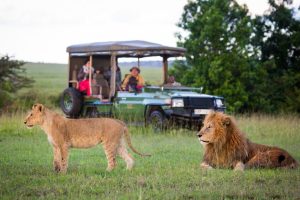Uganda hosts several stunning lakes that attract lesser flamingos, especially during the dry season when water levels drop and algae concentrations increase. Lake Munyanyange, located in Queen Elizabeth National Park, draws large flocks because it provides the shallow, alkaline waters that flamingos prefer. These waters teem with algae, which flamingos feed on by filtering water through their specialized bills. Lake Katwe, also within Queen Elizabeth National Park, offers similar conditions and hosts a diverse range of bird species alongside flamingos. Lake Bunyonyi, known for its scenic islands and terraced hillsides, occasionally attracts migrating lesser flamingos, creating excellent opportunities for birdwatchers to witness these birds in a serene, picturesque environment.
When Is the Best Time to See Lesser Flamingos in Uganda?
Visitors see the highest concentrations of lesser flamingos during the dry seasons, from December to March and June to August. During these periods, the lakes shrink slightly, which concentrates the flamingos in smaller areas and makes observation easier. From December to March, flamingos feed on the abundant algae that flourish after the rainy season. From June to August, migratory birds arrive from breeding grounds in Tanzania, swelling the numbers even further. Travelers who schedule their visits during these months increase their chances of observing large, active flocks, which create spectacular, photogenic scenes against the shimmering lake waters.
What Is the Habitat of Lesser Flamingos in Uganda?
Lesser flamingos thrive in Uganda’s specialized lake habitats. They rely on alkaline lakes because the high pH supports the growth of cyanobacteria and algae, their primary food source. These birds prefer shallow waters where they can wade and filter-feed efficiently, using their uniquely adapted beaks. The lakes often sit in volcanic or crater landscapes, which keep human disturbances minimal and maintain the water chemistry that flamingos need. Lesser flamingos select lakes with calm, isolated conditions, avoiding areas with heavy human activity. Their habitats also support a variety of other birds, making these ecosystems rich in biodiversity and essential for wetland health.
How Can You Reach These Flamingo Habitats?
Travelers can access Uganda’s flamingo habitats by road, but many areas require careful planning due to their remote locations. Visitors reach Lake Munyanyange via the Katwe area in Queen Elizabeth National Park, and local guides often help navigate the terrain and locate the flocks. Lake Katwe, accessible through the park’s main entrances, attracts birdwatchers who combine flamingo observation with exploration of the park’s other wildlife. Lake Bunyonyi sits between Kabale and Kisoro districts, reachable by well-maintained roads. Visitors often combine flamingo observation with boat trips on the lake, which offers views of its islands, surrounding hills, and occasional flocks of flamingos feeding along the shoreline.
What Should You Bring for Flamingo Watching?
Birdwatchers and photographers benefit from careful preparation. Binoculars allow close observation without disturbing the birds, and a camera with a zoom lens captures stunning details of the pink flocks. Travelers should wear sturdy, comfortable shoes because the shores and surrounding terrain can be muddy or rocky. Sun protection, including sunscreen, hats, and sunglasses, helps prevent sunburn during long observation sessions. Visitors should carry water and snacks, especially when exploring remote areas where amenities are scarce. A bird field guide also helps identify lesser flamingos and other species in the area, enriching the wildlife experience.
Are There Guided Tours Available for Flamingo Watching?
Guided tours enhance the flamingo-watching experience. Tour operators provide expert guides who know the best observation points, migratory patterns, and feeding behaviors of lesser flamingos. Tours often include transportation to and from the lakes, which allows travelers to focus on observing and photographing the birds. Some guides provide binoculars, spotting scopes, and field advice for identifying other bird species. Guided tours also educate visitors about local communities, lake ecosystems, and the importance of conservation. By joining a guided tour, travelers gain an organized, informative, and safe experience while supporting local ecotourism initiatives.
What Other Bird Species Can You See Alongside Lesser Flamingos?
Lakes that host lesser flamingos also support diverse bird populations. Visitors often observe greater flamingos, which occasionally share feeding grounds. Pelicans glide over the water and feed alongside flamingos, while herons and egrets patrol the shallow edges for small fish and invertebrates. Waders, sandpipers, and plovers forage along the shores, adding further variety for birdwatchers. Uganda’s national bird, the Grey Crowned Crane, frequents wetland areas near flamingo habitats, providing a striking visual contrast. Observers can document multiple species in one trip, making these lakes hotspots for birdwatching enthusiasts and wildlife photographers.
How Can You Contribute to Flamingo Conservation in Uganda?
Visitors can actively support flamingo conservation by following several simple practices. They should maintain a respectful distance from feeding and nesting areas to avoid stressing the birds. Travelers can support local conservation organizations financially or through volunteer programs that protect flamingo habitats. Educating others about the ecological importance of flamingos encourages wider community involvement in conservation. Birdwatchers can also participate in citizen science initiatives, such as recording flamingo numbers or monitoring lake conditions. These actions help preserve Uganda’s flamingo populations and protect the delicate ecosystems they rely on for survival.
Why Are Lesser Flamingos Important to Uganda’s Ecosystems?
Lesser flamingos play a crucial ecological role in Uganda’s lakes. Their feeding helps control algae growth, preventing water over-enrichment that could disrupt the ecosystem. By stirring the sediment and filtering water, they support nutrient cycling, which benefits other aquatic organisms. Flamingos also attract tourists, creating economic incentives for local communities to protect wetlands. As indicator species, changes in flamingo populations can signal environmental issues, such as water pollution or habitat degradation. Observing these birds allows scientists, conservationists, and travelers to gauge the health of Uganda’s wetland ecosystems while enjoying one of the region’s most remarkable natural spectacles.
Conclusion
Uganda offers travelers extraordinary opportunities to see lesser flamingos in their natural habitats. Lakes such as Munyanyange, Katwe, and Bunyonyi provide shallow, algae-rich waters where flocks gather in impressive numbers, particularly during the dry seasons. By preparing properly, joining guided tours, and respecting wildlife, visitors can experience these birds up close while contributing to conservation efforts. The lakes also host a rich variety of other bird species, creating a dynamic environment for observation and photography. Protecting these habitats ensures that Uganda’s lesser flamingos continue to thrive, offering future generations the chance to witness their vibrant beauty.




